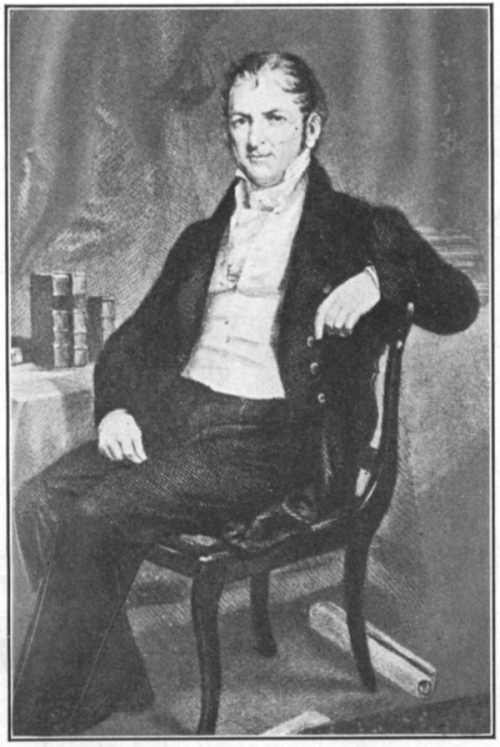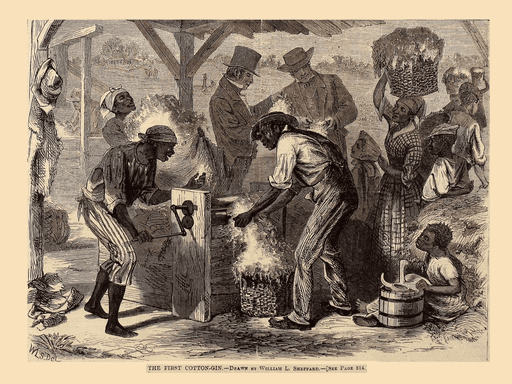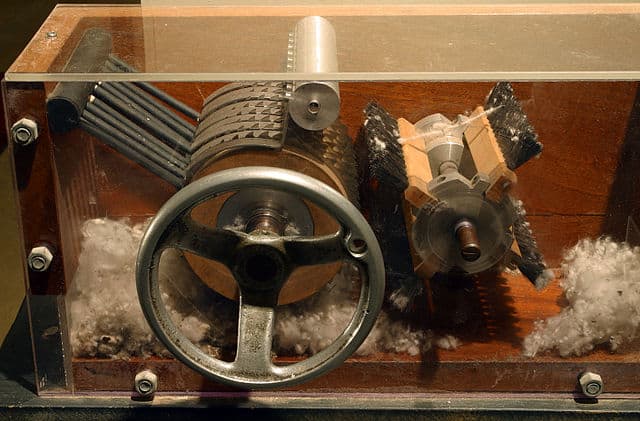Top 15 Facts about Eli Whitney
Originally published by Vanessa R on February 2022. Edited by Charity K on May 2023.

Eli Whitney by Project Gutenberg from Wikimedia Commons
Whitney essentially cemented the foundations of slavery in the United States by making cotton a profitable crop. However, his life’s work isn’t solely focused on – regrettably – slavery and cotton farming.
Continue reading to learn the top fifteen fascinating facts about Eli Whitney!
Read more on famous inventors of all time here.
1. He started a business when he was only 14
The Revolutionary War was in full swing when Eli Whitney was 14 years old. An intriguing detail about Eli Whitney is that he ran a nail-making business out of his father’s workshop (his father was a rich farmer). He also made a large profit.
2. He was a creative inventor
Eli Whitney is noted for not just developing the cotton gin, but also for advocating for interchangeable parts. As a maker of muskets, he accepted and strongly promoted this idea but he wasn’t the inventor. However, he was able to deal with his financial challenges when he took on a government armaments contract and built his muskets using interchangeable parts.
3. He was admitted to Yale University
Eli Whitney was accepted to Yale University for his undergraduate studies and graduated in three years (as opposed to the typical four years for a US university), which is an intriguing fact about Eli Whitney. He was also a member of Phi Beta Kappa, an honor society for those who had excelled academically.
Click here to read more about famous inventors from different parts of the world.
4. Whitney worked on a lot of items before the cotton gin
Eli Whitney was able to work on a variety of projects before discovering his innovations, because of his curiosity and intelligence. Nails, canes, and ladies’ hatpins were among the items made.
5. He faked it to make it
Whitney’s production of muskets, and hence the utilization of replaceable components in this operation, was one of his major accomplishments. He was, however, bluffing when he got the government contract to deliver 10,000 muskets. He didn’t have a factory or enough workers to produce that many muskets!
6. Whitney’s cotton gin company went out of business

Cotton gin by William L. Sheppard from Wikimedia Commons
The cotton gin is a machine that removes seeds from cotton. Its significance is that it made the entire process of using cotton much faster and more cost-effective. This considerably aided the economic development of the Southern United States and made slavery more sustainable.
Rather than selling the devices, Whitney planned to charge farmers for washing their cotton. In 1794, he was granted a patent for the cotton gin, but it was not recognized until 1807. As a result of farmers’ dissatisfaction with his approach and the machine’s ease of copying, a slew of infringements occurred. He and his business partner, Phineas Miller was unable to meet the demand for cotton gins, which made the offerings of others all the more appealing. Overall, because the cost of patent infringement battles consumed all of Whitney and Miller’s income, the cotton gin company fell out of business in 1797, which is a little-known truth about Eli Whitney.
7. Whitney’s cotton design had many flaws

Cotton gin created by Tom Murphy VII from Wikimedia Commons
There is evidence that Whitney’s invention, while the foundation of the cotton gin that was widely utilized, had problems. In truth, there were a few architectural flaws that Mrs. Greene, Whitney’s sponsor and the owner of the plantation where he worked, fixed for him. He didn’t give her any credit or public acknowledgment for her assistance.
Click here to read more about famous inventors.
8. He was wrongfully credited with inventing the milling machine

Eli Whitney Cotton Gin by Digital Collections-Wikimedia Commons
He is credited with inventing the milling machine, according to historian Joseph W. Roe. This, however, proved to be inaccurate. In the years 1814-1818, Whitney was part of a group of innovators who were all working on milling machines at the same time. Others, however, made more significant contributions and no single person can be credited with this innovation conclusively and definitively, which is a fascinating truth about Eli Whitney. Furthermore, it appears that the machine studied by Joseph Roe was built after Whitney’s death, in 1825.
9. He died of prostate cancer
Later in life, Eli Whitney was diagnosed with prostate cancer. He experimented with a variety of technologies to assist him to cope with his pain. However, his family kept these a secret and never revealed them, despite the fact that they were said to be quite successful.
10. Whitney had no intention of becoming an innovator
Young Eli Whitney, despite his fate, planned to study law after graduating from Yale. But, due to a lack of funds, he accepted an opportunity to work as a private tutor in South Carolina. He stopped in Georgia along the way, which was a popular location for New Englanders trying to earn a fortune.
As Eli sailed into South Carolina, he encountered the widow and family of Revolutionary War hero General Nathanael Greene. Whitney was invited to Mrs Greene’s Georgia farm, where he would later work on the cotton gin and meet Mrs Greene’s plantation manager, Phineas Miller, who would later become his cotton gin, business partner.
Without the cotton gin that he invented, cotton production would have remained exceedingly laborious and so inefficient, potentially leading to the abolition of slavery.
Instead, his invention resulted in the importation of a large number of slaves to the United States, since cotton farming became a lucrative business and the primary source of wealth in the Southern states. This was known as “King Cotton,” an economic power that kept slavery alive while also encouraging Southern states to secede from the North.
11. His Legacy After Death
Scholars note that while Eli was sick, he invented and constructed several devices to mechanically ease his pain. Yale University honored him by naming an admissions program for non-traditional students after him. The program offers students with high academic potential the opportunity to enroll in Yale College for completion of the B. A or B.S degree.
12. The Eli Whitney Museum
The museum has exhibits on his most famous invention the cotton gin, and the erector site. The museum specializes in building projects for children blending science and invention.
The Museum has about 60 apprentices at a time paid, and hands-on experience. The Apprentices are aged between 13 and 18 and work 200 hours through the school year and 400 hours in the summer.
13. The Educational Benefits of His Museum
It is an experimental learning workshop for students, families, and teachers. Its main building is located on a portion of the Eli Whitney Gun Factory. The museum’s main goal focuses on teaching experiments that are the roots of the design and invention of Whitney. In addition, it has special designs.
14. Whitney’s Father As A Justice of The Peace
Eli’s father was a respectable farmer who served as a justice of the peace. The title is given to a local magistrate empowered chiefly to administer civil justice in minor cases. They can also administer oaths and perform marriages in some jurisdictions.
15. The Invention of Muskets

ROY KLOTZ M.D., CC BY-SA 3.0, via Wikimedia Commons
Whitney’s most notable achievement was the use of interchangeable parts to mass-produce firearms. Scholars note it as one of the greatest contributions to the security industry by creating a manufacturing process for making muskets. He built the factory in 1798 near New Haven, Connecticut. In less than two years, Eli was able to manufacture 10,000 muskets.
Click here to read more about famous inventors.
Planning a trip to Paris ? Get ready !
These are Amazon’s best-selling travel products that you may need for coming to Paris.
Bookstore
- The best travel book : Rick Steves – Paris 2023 – Learn more here
- Fodor’s Paris 2024 – Learn more here
Travel Gear
- Venture Pal Lightweight Backpack – Learn more here
- Samsonite Winfield 2 28″ Luggage – Learn more here
- Swig Savvy’s Stainless Steel Insulated Water Bottle – Learn more here
Check Amazon’s best-seller list for the most popular travel accessories. We sometimes read this list just to find out what new travel products people are buying.










